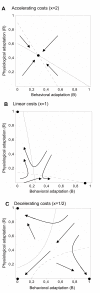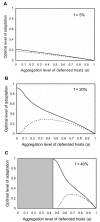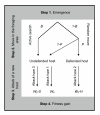Avoid, attack or do both? Behavioral and physiological adaptations in natural enemies faced with novel hosts
- PMID: 16271142
- PMCID: PMC1298290
- DOI: 10.1186/1471-2148-5-60
Avoid, attack or do both? Behavioral and physiological adaptations in natural enemies faced with novel hosts
Abstract
Background: Confronted with well-defended, novel hosts, should an enemy invest in avoidance of these hosts (behavioral adaptation), neutralization of the defensive innovation (physiological adaptation) or both? Although simultaneous investment in both adaptations may first appear to be redundant, several empirical studies have suggested a reinforcement of physiological resistance to host defenses with additional avoidance behaviors. To explain this paradox, we develop a mathematical model describing the joint evolution of behavioral and physiological adaptations on the part of natural enemies to their host defenses. Our specific goals are (i) to derive the conditions that may favor the simultaneous investment in avoidance and physiological resistance and (ii) to study the factors that govern the relative investment in each adaptation mode.
Results: Our results show that (i) a simultaneous investment may be optimal if the fitness costs of the adaptive traits are accelerating and the probability of encountering defended hosts is low. When (i) holds, we find that (ii) the more that defended hosts are rare and/or spatially aggregated, the more behavioral adaptation is favored.
Conclusion: Despite their interference, physiological resistance to host defensive innovations and avoidance of these same defenses are two strategies in which it may be optimal for an enemy to invest in simultaneously. The relative allocation to each strategy greatly depends on host spatial structure. We discuss the implications of our findings for the management of invasive plant species and the management of pest resistance to new crop protectants or varieties.
Figures





Similar articles
-
Defence against multiple enemies.J Evol Biol. 2003 Nov;16(6):1319-27. doi: 10.1046/j.1420-9101.2003.00585.x. J Evol Biol. 2003. PMID: 14640423
-
Evolution of Host Defense against Multiple Enemy Populations.Am Nat. 2016 Mar;187(3):308-19. doi: 10.1086/684682. Epub 2016 Jan 8. Am Nat. 2016. PMID: 26913944
-
Plant chemistry and natural enemy fitness: effects on herbivore and natural enemy interactions.Annu Rev Entomol. 2006;51:163-85. doi: 10.1146/annurev.ento.51.110104.151110. Annu Rev Entomol. 2006. PMID: 16332208 Review.
-
Cuckoos versus hosts in insects and birds: adaptations, counter-adaptations and outcomes.Biol Rev Camb Philos Soc. 2011 Nov;86(4):836-52. doi: 10.1111/j.1469-185X.2010.00173.x. Epub 2011 Jan 12. Biol Rev Camb Philos Soc. 2011. PMID: 21223481 Review.
-
Enemy-free space for parasitoids.Environ Entomol. 2014 Dec;43(6):1465-74. doi: 10.1603/EN13201. Environ Entomol. 2014. PMID: 25479197
Cited by
-
The rising impact of mathematical modelling in epidemiology: antibiotic resistance research as a case study.Epidemiol Infect. 2008 Mar;136(3):289-98. doi: 10.1017/S0950268807009442. Epub 2007 Sep 4. Epidemiol Infect. 2008. PMID: 17767792 Free PMC article. Review.
References
-
- Chew FS. Coevolution of pierid butterflies and their cruciferous foodplants. II. The distribution of eggs on potential foodplants. Evolution. 1977;31:568–579. - PubMed
-
- Pluthero FG, Threlkeld SFH. Genetic differences in malathion avoidance and resistance in Drosophila. J Econ Entomol. 1981;74:736–740. - PubMed
-
- Pluthero FG, Sing RS, Threlkeld SFH. The behavioural and physiological components of malathion resistance in Drosophila melanogaster. Can J Genet Cytol. 1982;24:807–815.
-
- Lockwood JA, Sparks TC, Story RN. Evolution of insect resistance to insecticides: a reevaluation of the roles of physiology and behavior. Bull Entomol Soc Am. 1984. pp. 41–51.
Publication types
MeSH terms
LinkOut - more resources
Full Text Sources

